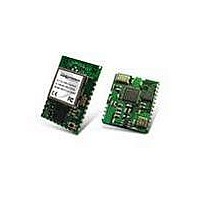WI.232EUR-R Radiotronix, WI.232EUR-R Datasheet - Page 15

WI.232EUR-R
Manufacturer Part Number
WI.232EUR-R
Description
EMBEDDED RADIO MODULE
Manufacturer
Radiotronix
Datasheet
1.RK-WI.232EUR-R.pdf
(29 pages)
Specifications of WI.232EUR-R
Frequency Rf
869.885MHz
Module Interface
Serial, UART
Tool / Board Applications
Wireless Connectivity-ZigBee, RF, Infrared, USB
Sensitivity
-106dBm
Data Rate Max
76.8Kbps
Supply Current
65mA
Maximum Frequency
869.885 MHz
Supply Voltage (max)
3.6 V
Supply Voltage (min)
2.7 V
Maximum Operating Temperature
+ 85 C
Minimum Frequency
868.225 MHz
Minimum Operating Temperature
- 40 C
Product
RF Modules
Frequency Range
868.225MHz To 869.885MHz
Supply Voltage Range
2.7V To 3.6V
Rohs Compliant
Yes
Lead Free Status / RoHS Status
Lead free / RoHS Compliant
Lead Free Status / RoHS Status
Lead free / RoHS Compliant
Line
CTS
CMD
RXD
TXD
Table 2, Wi.232EUR UART Interface Lines
7.7.
The module is designed to work with any 50-ohm antenna, including PCB trace antennas.
We are often asked: “What is the best antenna to use with your module?” Actually, the selection
of an antenna is based on a particular application, not the module used.
As a rule, either a ¼ wave whip or ½ wave dipole antenna paired with a good, solid ground plane
are good choices. However, many embedded applications cannot support an externally mounted
antenna. If this is the case, a PCB antenna must be used. The designer can either use an off-of-
the-shelf PCB antenna, or design a trace antenna.
Note: Antenna design is difficult and can be impossible without the proper test equipment. As
such, we strongly encourage all of our customers to use off-of-the-shelf antennas whenever
possible.
7.8.
A link budget is the best figure of merit for comparing wireless solutions and determining how
they will perform in the field.
In general, the solution with the best link budget will deliver the best line-of-sight range
performance. Improving the link budget by increasing the receiver sensitivity will result in lower
power consumption while improving the link budget by increasing the transmit power will result in
more robust performance in the presence of an on-channel interferer or multi-path interference.
Wireless Fact: Frequency hopping spread spectrum does not effectively combat multipath
interference in the 868-870 MHz band. It does combat in-channel interference, but at the
expense of bandwidth, power consumption, and latency. Direct sequence spread spectrum, like
FHSS, does not combat multipath interference. It does do a better job than FHSS at combating
in-channel interference, but at the expensive of occupied bandwidth and power consumption.
These spread spectrum techniques are generally chosen because higher output powers are
allowed from a transmitter employing these techniques.
To calculate the link budget for a wireless link, simply add the transmit power, the antenna gains,
and the receiver sensitivity:
Wi.232EUR User’s Manual
LB
=
Ptx
Antenna
Link budget, transmit power, and range performance
+
Gtxa
Direction
Out
In
In
Out
−
SENSrx
Description
Clear to send – this pin indicates to the host micro when it is ok to send data.
When CTS is high, the host micro should stop sending data to the module until
CTS returns to the low state.
Command – the host micro will bring this pin low to put the module in
command mode. Command mode is used to set and read the internal
registers that control the operation of the module. When CMD is high,
the module will transparently transfer data to and from other modules
on the same channel.
NOTE: If this pin is low when the module comes out of reset, the registers will
be reset to their factory programmed defaults. It is important to ensure that
CMD is held high during power-up under normal conditions.
Receive data input.
Transmit data output
+
Grxa
© 2003-2007 Radiotronix Inc.
14














